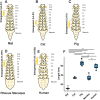Comparative neuroanatomy of the lumbosacral spinal cord of the rat, cat, pig, monkey, and human
- PMID: 33479371
- PMCID: PMC7820487
- DOI: 10.1038/s41598-021-81371-9
Comparative neuroanatomy of the lumbosacral spinal cord of the rat, cat, pig, monkey, and human
Abstract
The overall goal of this work was to create a high-resolution MRI atlas of the lumbosacral enlargement of the spinal cord of the rat (Sprague-Dawley), cat, domestic pig, rhesus monkey, and human. These species were chosen because they are commonly used in basic and translational research in spinal cord injuries and diseases. Six spinal cord specimens from each of the studied species (total of 30 specimens) were fixed, extracted, and imaged. Sizes of the spinal cord segments, cross-sectional dimensions, and locations of the spinal cord gray and white matter were quantified and compared across species. The lumbar enlargement spans spinal cord levels L3-S1 in rats, L4-S1 in cats, L3-S1 in pigs, L2/L3-L7/S1 in monkeys, and T12/L1-S1/S2 in humans. The enlargements in pigs and humans are largest and most similar in size (length and cross-sectional area); followed by monkeys and cats; and followed by rats. The obtained atlas establishes a neuroanatomical reference for the intact lumbosacral spinal cord in these species. It can also be used to guide the planning of surgical procedures of the spinal cord and technology design and development of spinal cord neuroprostheses, as well as precise delivery of cells/drugs into target regions within the spinal cord parenchyma.
Conflict of interest statement
The authors declare no competing interests.
Figures













References
-
- Hardiman O, et al. Amyotrophic lateral sclerosis. Nat. Rev. Dis. Primers. 2017;3:1–19. - PubMed
-
- WHO | Spinal cord injury: as many as 500 000 people suffer each year. WHOhttp://www.who.int/mediacentre/news/releases/2013/spinal-cord-injury-201... (2019).
Publication types
MeSH terms
Grants and funding
LinkOut - more resources
Full Text Sources
Other Literature Sources
Miscellaneous

